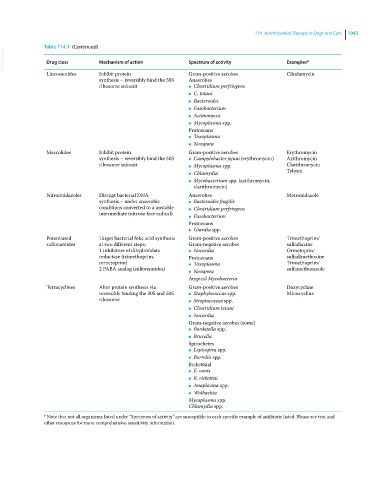Page 1105 - Clinical Small Animal Internal Medicine
P. 1105
114 Antimicrobial Therapy in Dogs and Cats 1043
Table 114.1 (Continued)
VetBooks.ir Drug class Mechanism of action Spectrum of activity Examples*
Lincosamides Inhibit protein Gram‐positive aerobes Clindamycin
synthesis – reversibly bind the 50S Anaerobes
ribosome subunit ● Clostridium perfringens
● C. tetani
● Bacteroides
● Fusobacterium
● Actinomyces
● Mycoplasma spp.
Protozoans
● Toxoplasma
● Neospora
Macrolides Inhibit protein Gram‐positive aerobes Erythromycin
synthesis – reversibly bind the 50S ● Campylobacter jejuni (erythromycin) Azithromycin
ribosome subunit ● Mycoplasma spp. Clarithromycin
● Chlamydia Tylosin
● Mycobacterium spp. (azithromycin,
clarithromycin)
Nitroimidazoles Disrupt bacterial DNA Anaerobes Metronidazole
synthesis – under anaerobic ● Bacteroides fragilis
conditions converted to a unstable ● Clostridium perfringens
intermediate (nitroso free radical)
● Fusobacterium
Protozoans
● Giardia spp.
Potentiated Target bacterial folic acid synthesis Gram‐positive aerobes Trimethoprim/
sulfonamides at two different steps: Gram‐negative aerobes sulfadiazine
1 Inhibitors of dihydrofolate ● Nocardia Ormetoprin/
reductase (trimethoprim, Protozoans sulfadimethoxine
ormetoprim) ● Toxoplasma Trimethoprim/
2 PABA analog (sulfonamides) sulfamethoxazole
● Neospora
Atypical Mycobacteria
Tetracyclines Alter protein synthesis via Gram‐positive aerobes Doxycycline
reversibly binding the 30S and 50S ● Staphylococcus spp. Minocycline
ribosome ● Streptococcus spp.
● Clostridium tetani
● Nocardia
Gram‐negative aerobes (some)
● Bordetella spp.
● Brucella
Spirochetes
● Leptospira spp.
● Borrelia spp.
Rickettsial
● E. canis
● R. rickettsii
● Anaplasma spp.
● Wolbachia
Mycoplasma spp.
Chlamydia spp.
* Note that not all organisms listed under “Spectrum of activity” are susceptible to each specific example of antibiotic listed. Please see text and
other resources for more comprehensive sensitivity information.

